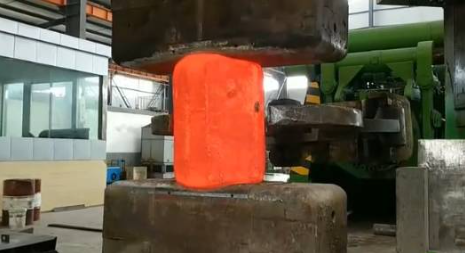Aviation titanium alloy parts forging
Titanium is an important structural metal developed in the 1950s, and titanium alloys are widely used in various fields because of their high strength, good corrosion resistance, and high heat resistance. Many countries in the world have recognized the importance of titanium alloy materials, research, and development of its successive and practical applications.
In the 1950s to 1960s, the main development of high-temperature titanium alloys for aircraft engines and structural titanium alloys for airframes, the 1970s to develop a number of corrosion-resistant titanium alloys, and since the 1980s, corrosion-resistant titanium alloys and high-strength titanium alloys have been further developed. Titanium alloys are mainly used to make aircraft engine compressor components, followed by structural parts for rockets, missiles, and high-speed aircraft.
Titanium is an isomer with a melting point of 1668°C. Below 882°C, it has a dense hexagonal lattice structure, called α-titanium; above 882°C, it has a body-centered cubic lattice structure, called β-titanium. Using the above two structural characteristics of titanium, add the appropriate alloying elements so that its phase change temperature and phase content gradually change and get different organizations of titanium alloys (titanium alloys). At room temperature, titanium alloys have three kinds of matrix organization, and titanium alloys are divided into the following three categories: α alloy, (α + β) alloy, and β alloy. In China, they are expressed as TA, TC, and TB respectively.

Alpha titanium alloy is a single-phase alloy composed of α-phase solid solution, whether at general temperature or at higher actual application temperature, it is α-phase, with stable organization, higher wear resistance than pure titanium, and strong oxidation resistance. In the temperature of 500 ~ 600 ℃, it still, maintains its strength and creep resistance, but can not be heat treated to strengthen, room temperature strength is not high.
β titanium alloy is a single-phase alloy composed of β-phase solid solution, titanium alloy without heat treatment has high strength, and quenching, the aging alloy is further strengthened, with room temperature strength up to 1372 ~ 1666 MPa; but the thermal stability is poor, not suitable for use at high temperatures.
α + β titanium alloy is a duplex alloy with good overall performance, good organizational stability, good toughness, plasticity, and high-temperature deformation properties, can be better for hot pressure processing, quenching, and aging to strengthen the alloy. The strength after heat treatment is about 50% to 100% higher than the annealed state; high-temperature strength, can work at a temperature of 400 ~ 500 ℃ for a long time, and its thermal stability is second to alpha titanium alloy.
The most common of the three titanium alloys is α titanium alloy and α + β titanium alloy; α titanium alloy has the best machinability, α + β titanium alloy is the second, β titanium alloy is the worst. α titanium alloy code TA, β titanium alloy code TB, α + β titanium alloy code TC.
Titanium alloys can be divided into heat-resistant alloys, high-strength alloys, corrosion-resistant alloys (titanium-molybdenum, titanium-palladium alloys, etc.), low-temperature alloys, and special functional alloys (titanium-iron hydrogen storage materials and titanium-nickel memory alloys). The composition and properties of typical alloys are shown in the table.
Heat-treated titanium alloys can have different phase compositions and organizations by adjusting the heat treatment process. It is generally believed that the fine equiaxial organization has better plasticity, thermal stability, and fatigue strength; the needle-like organization has higher endurance strength, creep strength, and fracture toughness; the mixed equiaxial and needle-like organization has better overall performance.
Titanium alloys have high strength and low density, good mechanical properties, good toughness, and corrosion resistance. In addition, the titanium alloy process performance is poor, and cutting and machining difficulties, in hot processing, very easy to absorb impurities such as hydrogen, oxygen, nitrogen, and carbon. There are also poor anti-wear properties, the production process is complex. The industrial production of titanium was started in 1948. The need for the development of the aviation industry, the titanium industry to an average annual growth rate of about 8%. The annual output of titanium alloy processing material in the world has reached more than 40,000 tons, and there are nearly 30 kinds of titanium alloy de grades. The most widely used titanium alloys are Ti-6Al-4V (TC4), Ti-5) Al-2.5Sn (TA7) and industrial pure titanium (TA1, TA2 and TA3).


